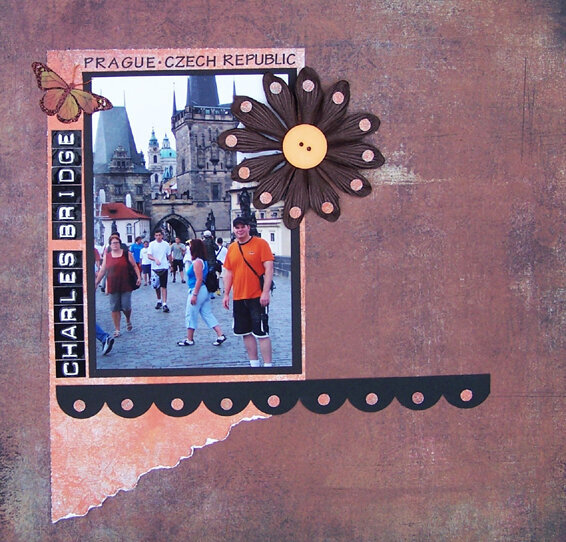

 Give a Cheer
Give a Cheer
With our Euro Trip just 4 days away I decided to scrap some pics from our last European Trip in 2006. This one is about Charles bridge - a famous historical bridge that crosses the Vltava river in Prague, Czech Republic. Its construction started in 1357 under the auspices of King Charles IV, and finished in the beginning of 15th century. As the only means of crossing the river Vltava (Moldau), the Charles Bridge used to be the most important connection between the Old Town, Prague Castle and adjacent areas until 1841. Also this 'solid-land' connection made Prague important as a trade route between east and west Europe. The bridge was originally called the Stone Bridge (Kamenný most) or the Prague Bridge (Pražský most) but has been the "Charles Bridge" since 1870.
The bridge is 516 meters long and nearly 10 meters wide, resting on 16 arches shielded by ice guards. It is protected by three bridge towers, two of them on the Lesser Quarter side and the third one on the Old Town side. The Old Town bridge tower is often considered to be one of the most astonishing civil gothic-style buildings in the world. The bridge is decorated by a continuous alley of 30 statues and statuaries, most of them baroque-style, erected around 1700.
The need for building a new bridge emerged after the old romanesque Judith Bridge (Juditin most, built around 1170 and named after king Vladislav I's wife Judith) was destroyed by a flood in 1342. The building began in 1357, was supervised by Peter Parler and led by a "magister pontis", Jan Ottl.
There is a modern legend saying that the foundation stone was laid in 1357 on the 7th day of the 9th month at 5:31 AM and that Charles IV chose this time so that when one writes out the opening time, they write the sequence of odd numbers, 1-3-5-7-9-7-5-3-1.
The bridge was built from Bohemian sandstone. There is a legend saying that eggs were used to enrich the mortar used to bind the stone blocks to make it harder. People from surrounding villages were asked to bring extra eggs to be used for the construction and many villages did not hesitate to contribute. What makes this legend live for centries is the part that tells about one village sending hard boiled eggs since they were worries fresh eggs would break.
No products have been added to this project.
Thanks for spreading positivity!
August 12, 2008
August 01, 2008
August 01, 2008
July 30, 2008
July 29, 2008
July 24, 2008
July 23, 2008
July 19, 2008
July 17, 2008
July 15, 2008
July 13, 2008
July 13, 2008
July 12, 2008
July 12, 2008
July 12, 2008
July 11, 2008
July 11, 2008
July 11, 2008
July 10, 2008
July 10, 2008
July 10, 2008
July 09, 2008
July 09, 2008
July 09, 2008
July 08, 2008
July 08, 2008
July 08, 2008
July 08, 2008
July 08, 2008
July 08, 2008
July 08, 2008
July 08, 2008
July 07, 2008
July 07, 2008
July 07, 2008
July 07, 2008
July 07, 2008
July 07, 2008
July 07, 2008
July 07, 2008
July 07, 2008
July 07, 2008
July 07, 2008
July 07, 2008
July 07, 2008
July 07, 2008
July 07, 2008
July 07, 2008
July 07, 2008
July 07, 2008
July 07, 2008
July 07, 2008
July 07, 2008
July 07, 2008
July 07, 2008
July 07, 2008
July 07, 2008
July 07, 2008
July 07, 2008
July 07, 2008
July 07, 2008
July 06, 2008
July 06, 2008
July 06, 2008
July 06, 2008
July 06, 2008
July 06, 2008
July 06, 2008
July 06, 2008